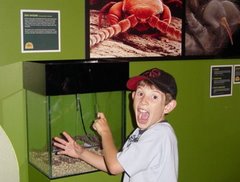What is it like to learn using computers and digital technologies and what do we think about the web? You can do anything, go anywhere in the world, and do anything unexpected and find anything. Web is about bringing things together and mixing them (people and things). Web opens new doors and new discoveries. Finding unexpected things, using shortcuts, learning more about how to use it. The internet is big, lots of stuff to discover and find out. Wild and unexpected and creative.
Next we went on a visit – one to the Palaeontology collection and one to the Museum's search and discover area. We were curious to find out how objects in the Museum could be made more interesting by supplementing them through digital technologies. All ideas were great and really useful. Some from my group were:
- An interactive collection space where you click on a cupboard, drawer etc and then have objects to explore
- 3D mapping of objects that you could rotate and explore further
We also got them to complete a survey with ten of their friends before they came here. The survey asked them questions about what they do online in order to compare to data we have collected from adults in Australia and the US. I'm still working on that! They also completed the sentence: Not being able to access the web is like not being able to ..., and here's some of what they said:
- Walk, breathe, talk, eat, survive, socialise
- Get access to water
- Open a chest
- Get an education
- Access a whole new world
- Go to school
- Wear clothes and be fashionable
- See the sun
- Travel around the world, explore my inner self or broaden my horizon
- Read a simple book
The final activity we did this morning was to think about websites b y looking at a site called ShowMe. This got a really bad review unfortunately and they felt that the site was developed by older people who weren't in touch with them ... Since they didn't like it we asked them to show us what sites they did like. Two sites from my group were FreeRice, where you learn about vocabulary/words while contributing to a good cause. They loved the colours and clean design of that site too. The other was MiniClip Games, for storing games which they felt was really well-organised, easy to find the games and fun as well.
One thing that struck me as they talked was that they felt the Museum's site was the place where we should store our content, videos, images and so on, not necessarily YouTube, Flickr and other places. They felt we should separate ourselves from what they perceive as fun sites – I'm not sure about this myself and is something that I'll be exploring further.



4 comments:
Hi Lynda,
Just want to know how do you classify some of the responses of the sentense. Why do you group 'socialise' into 'walk, breathe, talk, eat, survive' while you put 'get access to water' into different group? Why do you think that 'get an education' and 'go to school' are two different groups? Do the students really recognize that 'get an education' and 'go to school' are different?------- just want to know their opinions as well.
Tzu-yu
Hey there. I haven't classified the comments actually - was just saving room on the post! Sorry if I caused confusion.
At this stage we are still analysing all the data we collected - primarily the journals the students kept on the day. I'll post more as we're going and it will form part of our Museums and Web 2008 paper called From ladders of participation to networks of partcipation: social media and museum audiences.
Comments about the Free Rice website design made my day!
Inguna (Ante Meridiem Design) designer of the FreeRice website
Thanks. I love this site and recommend it to everyone. The students were particularly taken with it because it was for a good cause, and they learned too. Well done!
Post a Comment